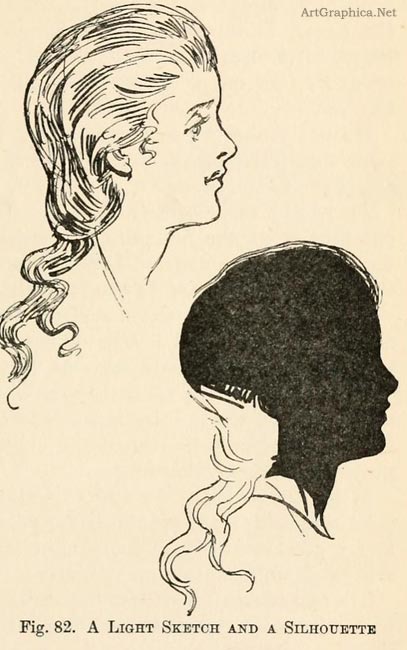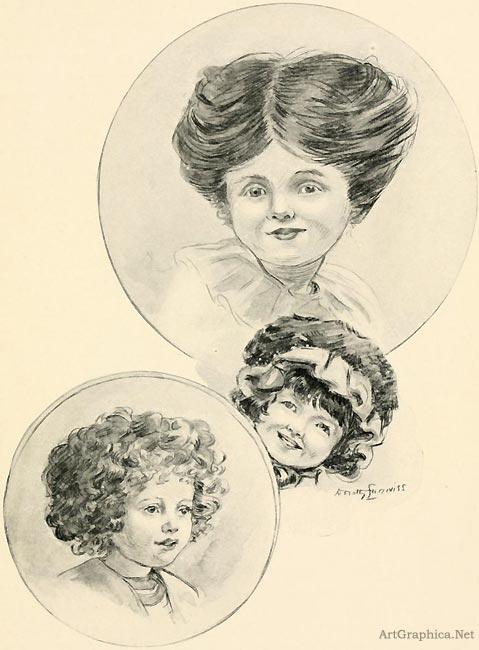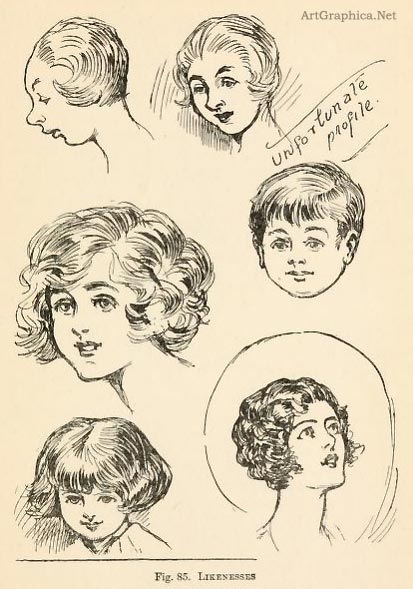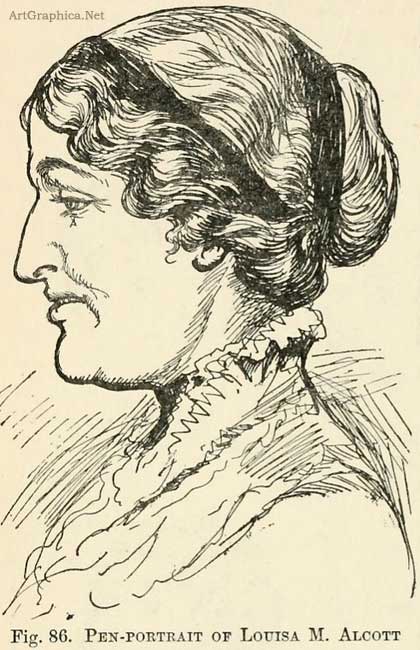Drawing for beginners
CHAPTER XIII
How to Catch a Likeness
THE word ' portraiture ' has an awe-inspiring sound. Portraiture is something that we may possibly attain in the far-off days when we are grown up.
Granted that the art of portraiture may be too ambitious for our humble pencil, yet there is every reason why we should train our eye, hand, and brain in the devious ways of catching a likeness. It will be a big help to the portrait-painting of the future.
The gift of catching a likeness, of transposing a recognizable drawing of a face to paper, is a very wayward gift. It does not follow that because we are artistic we shall have a flair for portraiture.
There are some people--far from artistic--who can catch a likeness.
There are many amateurs (by which I mean those artists who do not take the artistic profession seriously) who have a wonderful facility for drawing a likeness ; also there are very clever artists to whom the gift of portraiture is denied. All of which demonstrates that this peculiar gift lies apart from other branches of art.
Whether we have this gift, or whether we have merely a feeling that we should like ' to try our hand ' at sketching a likeness, it is our plain duty to make a few efforts, for it stimulates three very valuable qualities : it promotes carefulness, accuracy, and reasoning.
Now we might consider a few methods by which we may become proficient in this very elusive art.
Possibly at some time of your life you have amused yourself with sketching the shadows of your friends. You placed a candle or some other light at such an angle that the shadow of the profile was thrown on a sheet of paper pinned on a wall ; then by tracing the outline of the shadow with a soft pencil, or piece of charcoal, you secured an outline sketch. The size of the picture is its disadvantage. Who wants a life-sized outline of even their dearest and their best?
But in a sizable, careful little outline drawing of a friend's features filled with black ink or paint we have an old- fashioned method of portraiture--the silhouette.

Silhouette drawing is not such a difficult art as it might at first appear. It is, moreover, an excellent stepping-stone to the broad highway of. And it has two very popular advantages : it is quickly done, and it is pleasing when done.
Armed with a smooth card or a firm-surfaced paper, a pencil, a fine brush or pen, ivory black paint or black drawing ink, we have all that is necessary.
Ask your model to move his head aside till he presents his profile, then take up your pencil and lightly sketch head, face, features, neck, and hair.
Look critically at the proportions of your drawing. Compare your sketch with your model. Is the face the right size ? Does the forehead creep too high to the crest of the head ? Examine the curve from the brow to the bridge of the nose. Is it sufficiently indented ? Carefully note the length of the nose, the shape and projection of the upper and lower lip, the curve of the chin, and the moulding beneath the jaw.
Do not make the neck too thick. You can add bulk to your silhouette, but you can't take it away. Carefully note the shape of the head.
There are various methods of ' finishing' the neck. For our first essay the neck may be finished in a sloping curve beginning at the nape of the neck and sloping thence in a sharp curve downward to the forepart of the throat.
Always sketch the shape and position of the eye, also the nostril, ear, jaw, and corner of the mouth. This will help to check proportions and keep the features in place.
Having drawn the general shape of the coiled, floating, or clipped locks, the stubby moustache or beard, we shall find it easy to indicate the shape and character by the fine hairs projecting beyond the outline.
When the outline is ready to be filled with ink or paint (and supposing that paint will be your most likely medium) mix a good quantity of ivory black or sepia on the palette, and lay it on smoothly and evenly.
The silhouette filled and the outline firm and clear, you will note any projection of hair, frills, collar, lace, and ribbons. Draw these with a delicately fine line.
A word about the size of your silhouette. Do not make the drawing too large, but, on the other hand, do not aim at making it minute. If you sketch it no larger than a postage- stamp you will find it difficult to correct in the early stages ; and if you draw it very large you will lose the dainty effect that is the chief charm of the silhouette. One and a half inches high is a fairly reasonable size.
If you are not satisfied with your first attempts at a silhouette, do not despair, try again. Make another start-- sketch a fresh model. Do not expect to succeed without practice, for remember you are up against a difficult problem. You are not merely trying to depict ' a nose,' a face,' a head ' ; but a very special nose, face, and head.

Moreover, there is another excellent reason for many attempts. There is no satisfactory method of correcting a silhouette. If we make a false step and give too long a nose, too thick lips, too square a jaw, we cannot afterward amend our mistake. It is of course possible to take a brushful of thick white paint and fine down our outline. We can also use a scraper (a very sharp knife) and scrape at the surface of the paper. But neither method will be satisfactory. The pure, hard, sharp outline is the hall-mark of a good silhouette. The one unforgivable sin is the ragged edge.
It is a thrilling moment when we can trace a likeness between our model and our silhouette. And I can truthfully say that, given a little patience and intelligent application, there is no reason against, and every reason for, that happy result.
The drawing of likenesses in silhouette (for there are many other subjects to which we can apply this fascinating little art--sprays of leaves, birds, or fluffy animals, grotesque and quaint figures, landscapes of fantastic description, to quote but a few) has this advantage. It hides defects.
The double chin, the dragged lines of eye, mouth, and nostril, the wrinkles of forehead and face, the untidy head of hair--all are softened and veiled with the kindly brush.
Once your interest is aroused in portraiture the art of the silhouette will not wholly satisfy your cravings. It is a charming but, it must be admitted, a limited art.
Now we arc prepared to pass on to more ambitious subjects, and here I must offer a word of advice, for I do not want to make this difficult business of portraiture unnecessarily more difficult. We must go warily. The fascinating task of drawing likenesses is sometimes apt to give offence.
" That--my portrait ! " said an old lady, ruefully regarding a drawing of mine. " Ah, well ! "--following up with a sigh--" I was considered rather nice-looking in my day." The sad result was that the old lady refused to pose again, and the rest of the holiday was wasted, so far as further endeavours at sketching a likeness were concerned.
It is just as well to bear in mind what was written of Sir Joshua Reynolds, the great portrait-painter of the eighteenth century :
His pencil was striking, resistless, and grand ;
His manners were gentle, complying, and bland ;
Still born to improve us in every part,
His pencil our faces, his manner our heart.
Compare our beloved Sir Joshua with the Chinese painter who, like most Chinese artists, was excellent at copying a likeness, defect and blemish complete, and to whom one of his sitters objected that he had not made him handsome enough. The painter replied, blandly but firmly :
" No hab got handsome face, how can hab handsome picture ? "
Supposing that it is your intention to sketch the likeness of a person who has what is sometimes called an unfortunate profile, you should not pitch on the particular position of a profile for choice.
The pencil says that my model has a small eye, snub nose, receding chin, and it records these facts remorselessly. It may not mean to be unkind. But the outline is such and down it goes.

Fig. 84. EXPRESSION IN PORTRAITS
In such a case a three-quarter view, or even a full face would be wiser--and kinder.
Some people run away with the idea that portraiture is merely seeking out defects and exaggerations--but that is caricature.
We should look for the pleasing characteristics. We do not, it is true, wish to draw the pretty pretty ' face--the chocolate-box style of beauty--but there is no reason against recording pleasant rather than unpleasant facts. It takes a very big man to rise above facial defects, and an Oliver Cromwell to wish to be painted warts and all.'
We will presume that a group of girls and boys are waiting primed ready to sketch portraits. And one has been selected, or very good-naturedly volunteers, to sit as a model. Some one remarks, not very politely and a little despairingly, " There's absolutely nothing in Rachel that isn't just ordinary ! "
Ordinary ; what is ordinary ' ? ' Common, customary,' says the dictionary (among other things).
Is Rachel ' ordinary ' compared with the rest ?
Look swiftly from Rachel's lips to those of Patricia. Rachel's upper lip is ever so short ' compared with Patricia's rather pouting mouth ; and her eye--she has a fine-lidded eye, with clear, open pupil. John's eye is slightly hidden by his brow, and his iris is dark. And compare the three pairs of eyebrows. Rachel's extend thickly from the nose to the outer edge of the eye, Patricia's are thin and silky, and John's are queer little dabs of hair, one of which gives a humorous twist and expression to his face.
Expression, ah !--now we are getting to the root of this portrait business. . . .
Let us break off for a moment.
When we have seen a portrait by a famous artist--or the reproduction of one--what lingers most clearly in our minds ? Does not the expression haunt our memories ?
To quote a few of the greatest portraits in the world :
Think of the gentle austerity of Titian's Doctor, the shy
grace of Velasquez's Baby Princess, the demure questioning of Reynolds' Strawberry Girl, and the tragic dignity of Rembrandt's Old Woman.
I doubt if you could give the faintest description of the features of one of these portraits.
And now let us look at our portrait of Rachel or Margery.
That may be Margery's eye, nose, mouth, chin, hair, and ear, but if we have missed Margery's mischievous look, the wicked twinkle in her bright eye, the twitching curve of her lips, and the jaunty tilt of her glossy head ; in short, if we have not captured her expression, Margery's portrait is no portrait at all.
When we draw likenesses we must not labour first with one feature and then with another, but try to grasp everything together.
We begin by noting any peculiarity, such as the poise of the head on the shoulders, afterward roughing out the angles of the features, or the arrangement of large masses such as a woman's hair or a man's beard ; then we confine ourselves to the drawing of the features.
There is no sense in racing along if by nature you are a plodder. We must all ' gang our ain gait.'
Personally, however, I have a feeling, or rather a conviction, that if I cannot capture something of the likeness in the earliest stages it will always elude me.
From the very first attack the angle of the head, the placing of the neck on the shoulders, the cock of the eye, the droop of the lip.
There is another point to bear in mind. Do not get too easily discouraged. Don't be depressed if your efforts do not gain immediate success. You must try many times before you can hope to be proficient.
After all, you do not expect to play a sonata of Beethoven's, or to write a thesis on an abstruse subject, or to compose an exquisite lyric--without practice.
And remember too that you are in search of the unexpected. It is your business to find and record facts usually unnoticed by persons who are not artists.

Naturally some people are more easy to draw than others. Those with marked characteristics are the easiest of all. If you have any choice in the matter, choose some one with striking features, the drawing of which you cannot miss. Take your subtle and more delicate studies later.

When I was a child I was very fond of copying photographs of celebrities from papers and magazines --not such a bad method of training the eye and hand in the curious ways of catching a likeness. And I remember copying a charming profile of a certain little princess (her daughter is now as old as the picture to which I refer), and her Royal Highness's ear was of a prodigious size. If some one looked at the drawing without recognizing the subject I would say indignantly, " Oh, but you must see who it is by the ear ! " That I knew to be right. I was quite annoyed when a friend said with an air of surprise, " But I have never noticed the Princess's ear was so large ; surely you are mistaken."
You must he prepared for that sort of criticism. If you make it your business to observe things that are out of the way, you are certain to meet with such remarks.
It is not only with eyes, nose, ears, mouth, expression that we must be observant, but we must note and compare the little unobtrusive characteristics and traits which distinguish individuals.
One sits erect, another lolls in a languid manner, another slouches into awkward attitudes. Some perk up their chins, or incline their heads slightly to one side. All of which are valuable helps to the getting of a good likeness.
It will lessen your difficulties if you remember to leave a space between yourself and your model. It is a sheer impossibility to see such a large object as a human being in proportion unless we remove ourselves a good many paces away.
If you place yourself close to your model, as young artists often do, you will see the top of the head, the top of the shoulder, the upper part of the body, and the feet. You will have the curves of the features very much accentuated, and it will be exceedingly difficult to get the whole picture ' in drawing.'
Artists when painting full-length portraits invariably pose their models a good distance away from their easels, and sometimes the models are placed on a low platform. We can dispense with platforms, but we cannot dispense with distance.
Naturally, when drawing the head you can sit near your model with safety. But when the object is large then you must move away until you get a good and comprehensive view.
I would not discourage you from drawing people who happen to be near if you feel a strong desire to attempt it.
Do not resist the impulse to sketch some one who is bending over the same table as yourself, for example, but bear in mind that you are close to your model and make allowances.
It may be that you are not able to procure many sitters, that you live where there are very few people, and your opportunities of observation are therefore very restricted. That need not prevent you from drawing portraits. You must study the few. Even the greatest artists have contented themselves at times with a moderate range of subjects. And some of the finest portraits are the portraits of the artist's relations and friends. Gainsborough painted his own daughters. Some of Rubens' best portraits are those of his wife Helena ; Rembrandt was for ever painting himself, and his clever rubicund face eyes us shrewdly from many a canvas ; and there is the painting of Van Dyck himself with the sunflower.
And so we narrow our portrait-drawing down to ourselves. If you are driven to the drawing and painting of yourself (and it is always easier to draw other people, because one cannot back away from one's self and so get a good ' general ' view), and you are presumably standing before a looking- glass, remember this--you are drawing yourself not actually as you are but a size smaller.
A mirror reduces and makes us appear smaller, and this reduction forces the little things upon us at the expense of the more important.
It is very easy to prove this. Stand a few paces away from the looking-glass and ask some one to dab with a colour- brush the reflection of your head, the crest of your head and the tip of your chin, and measure this space with the brush against your own face. You will find that the looking-glass face is about a third the size of your own.
The art of catching a likeness, then, brings us to this point. We must first of all have good ground-work. We must practise drawing faces and features of various people in various positions.
We must draw with knowledge, riot guessing at things, sketching at random and trusting to luck.
We must be prepared to catch the fleeting look ; we must hold ourselves, as it were, on the very tiptoe of expectancy for the smile, the glance, the pout, the thoughtful or mirthful expression.
A line well expressed will send our hopes soaring high, and a line faulty and wrong will dash all those hopes to the ground. Never be daunted by mistakes, but take your courage in both hands and persevere.
Prev Page
Sketching in nature
|













